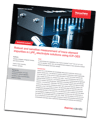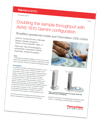Applications
 Composition characterization of lithium-rich minerals as an exploitable source of lithium using ICP-OES
Composition characterization of lithium-rich minerals as an exploitable source of lithium using ICP-OES
This application note describes an optimized analytical method for the analysis of a lithium containing mineral (zinnwaldite, a silicate based mineral of the approximate composition (KLiFeAl(AlSi3)O10(OH,F)2) using the Thermo Scientific™ iCAP™ PRO X ICP-OES Duo. Thorough testing of the method was performed, including demonstration of accuracy and precision by certified reference material measurements, analysis of quality control standards, and the analysis of real samples as required in a mineralogical research laboratory.
 Robust and sensitive measurement of trace element impurities in LiPF6 electrolyte solutions using ICP-OES
Robust and sensitive measurement of trace element impurities in LiPF6 electrolyte solutions using ICP-OES
One of the most common electrolytes in Li-ion batteries is lithium hexafluorophosphate (LiPF6) dissolved in a binary or ternary mixture of ethylene carbonate (EC) and linear carbonates. At the moment, there is only one standard method available for the analysis of electrolytes for lithium-ion batteries, based on the Chinese Standard HGT/ 4067-2015,4 which requires method detection limits of 1 mg·L-1 in the final LiPF6
electrolyte samples. The Thermo Scientific™ iCAP™ PRO ICP-OES Series can be the instrument of choice for this analysis, delivering detection limit performance well within the required range and providing a robust setup that can accurately characterize LiPF6 electrolyte sample materials. This note demonstrates the capabilities of ICP-OES for sensitive, robust, fast, and straightforward analysis of trace elements in lithium hexafluorophosphate electrolyte samples.

Determination of trace organic acids and inorganic anions in boric acid-treated power plant waters using an automated reagent-free ion chromatography system
Ion chromatography (IC) is an indispensable technique for the determination of trace
concentrations of ionic impurities found in power plant waters. Dionex AN185 describes
an automated RFIC method for the determination of trace anions in borated waters.2
After lithium removal with a Thermo Scientific™ Dionex™ CR-CTC II Continuously Regenerated Cation Trap Column the sample is concentrated before separating the anions using a Thermo Scientific™ Dionex™ IonPac™ AS15 column set and an electrolytically generated potassium hydroxide gradient.
Doubling the sample throughput with AI/AS 1610 Gemini configuration
A confident automation of liquid sample injection in a GC or GC-MS through a robust, reliable, and easy-to-use autosampler is what a high-throughput testing laboratory
needs to respond to a heavy workload. The enhanced usability of the Thermo Scientific AI/AS 1610 liquid autosampler makes this platform the fit-forpurpose solution, combining operational simplicity with injection mode flexibility. In order to support analytical testing laboratories facing high sample throughput demand, the dual-tower AI/AS 1610 Gemini configuration allows for simultaneous injection on two channels, doubling the throughput achievable on a single GC system, or confirming the same sample on two simultaneous runs. This Technical Note summarizes the main features of the Gemini configuration in combination with the Thermo Scientific™ Chromeleon™ Chromatography Data System (CDS) version 7.3, describing the different ways of operations.
Sponsor:


